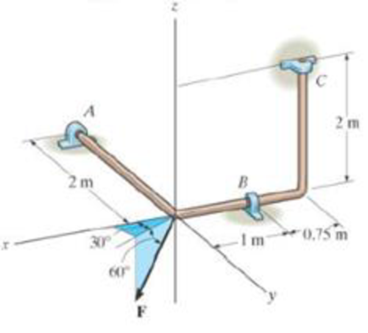
PEARSON ETEXT ENGINEERING MECH & STATS
15th Edition
ISBN: 9780137514724
Author: HIBBELER
Publisher: PEARSON
expand_more
expand_more
format_list_bulleted
Concept explainers
Textbook Question
Chapter 5, Problem 74P
The bent rod is supported at A, B, and C by smooth journal bearings. Determine the components of reaction at the bearings if the rod is subjected to the force F = 800 N. The bearings are in proper alignment and exert only force reactions on the rod.

Expert Solution & Answer
Want to see the full answer?
Check out a sample textbook solution
Students have asked these similar questions
Draw top, side, front view With pen(cil) and paper
Multi view drawing and handwriting all of it
A wheel of diameter 150.0 mm and width 37.00 mm carrying a load 2.200 kN rolls on a
flat rail. Take the wheel material as steel and the rail material as cast iron. Assume the
figure given, which is based on a Poisson's ratio of 0.3, is applicable to estimate
the depth at which the maximum shear stress occurs for these materials. At this critical
depth, calculate the Hertzian stresses σr, σy, σz, and Tmax for the wheel.
1.0
0.8
0, т
Ratio of stress to Pmax
0.4
0.6
90
69
0.2
0.5b
b
1.5b
Tmax
2b
Distance from contact surface
The Hertizian stresses are as follows:
02 = or = -23.8 psi for the wheel =|
necessary.)
σy for the wheel =|
MPa
σz for the wheel =
MPa
V4 for the wheel = |
MPa
2.5b
ཡི
3b
MPa (Include a minus sign if
Only question 3
Chapter 5 Solutions
PEARSON ETEXT ENGINEERING MECH & STATS
Ch. 5 - Determine the horizontal and vertical components...Ch. 5 - Determine the horizontal and vertical components...Ch. 5 - The truss is supported by a pin at A and a roller...Ch. 5 - Prob. 4FPCh. 5 - The 25 kg bar has a center of mass at G. If it is...Ch. 5 - Prob. 6FPCh. 5 - Determine the reactions at the supports. Prob....Ch. 5 - Determine the horizontal and vertical components...Ch. 5 - Determine the reactions at the supports. Prob....Ch. 5 - A uniform glass rod having a length L is placed in...
Ch. 5 - If the intensity of the distributed load acting on...Ch. 5 - Prob. 23PCh. 5 - Prob. 24PCh. 5 - Prob. 25PCh. 5 - Prob. 27PCh. 5 - Prob. 30PCh. 5 - Prob. 35PCh. 5 - The cantilevered jib crane is used to support the...Ch. 5 - Prob. 38PCh. 5 - Prob. 39PCh. 5 - Determine the stiffness k of each spring so that...Ch. 5 - The boom supports the two vertical loads. Neglect...Ch. 5 - Prob. 43PCh. 5 - The 10-kg uniform rod is pinned at end A. If It is...Ch. 5 - Prob. 46PCh. 5 - Prob. 47PCh. 5 - Prob. 48PCh. 5 - Prob. 53PCh. 5 - The uniform rod has a length I and weight W. It is...Ch. 5 - Prob. 7FPCh. 5 - Prob. 8FPCh. 5 - Prob. 9FPCh. 5 - Determine the support reactions at the smooth...Ch. 5 - Prob. 11FPCh. 5 - Determine the components of reaction that the...Ch. 5 - The uniform loads has a mass of 600 kg and is...Ch. 5 - The 100-lb door has its center of gravity at G....Ch. 5 - Determine me tension in each cable and the...Ch. 5 - The bent rod is supported at A, B, and C by smooth...Ch. 5 - The bent rod is supported at A, B, and C by smooth...Ch. 5 - Prob. 77PCh. 5 - Prob. 78PCh. 5 - Prob. 80PCh. 5 - Prob. 82PCh. 5 - The bar AB is supported by two smooth collars. At...Ch. 5 - Prob. 84PCh. 5 - Prob. 85PCh. 5 - Prob. 86PCh. 5 - Both pulleys are fixed to the shaft and as the...Ch. 5 - Member AB is supported by a cable BC and at A by a...Ch. 5 - Prob. 2RPCh. 5 - Prob. 4RP
Knowledge Booster
Learn more about
Need a deep-dive on the concept behind this application? Look no further. Learn more about this topic, mechanical-engineering and related others by exploring similar questions and additional content below.Similar questions
- In cold isostatic pressing, the mold is most typically made of which one of the following: thermosetting polymer tool steel sheet metal textile rubberarrow_forwardThe coefficient of friction between the part and the tool in cold working tends to be: lower higher no different relative to its value in hot workingarrow_forwardThe force F={25i−45j+15k}F={25i−45j+15k} lblb acts at the end A of the pipe assembly shown in (Figure 1). Determine the magnitude of the component F1 which acts along the member AB. Determine the magnitude of the component F2 which acts perpendicular to the AB.arrow_forward
arrow_back_ios
SEE MORE QUESTIONS
arrow_forward_ios
Recommended textbooks for you
 International Edition---engineering Mechanics: St...Mechanical EngineeringISBN:9781305501607Author:Andrew Pytel And Jaan KiusalaasPublisher:CENGAGE L
International Edition---engineering Mechanics: St...Mechanical EngineeringISBN:9781305501607Author:Andrew Pytel And Jaan KiusalaasPublisher:CENGAGE L

International Edition---engineering Mechanics: St...
Mechanical Engineering
ISBN:9781305501607
Author:Andrew Pytel And Jaan Kiusalaas
Publisher:CENGAGE L
Dynamics - Lesson 1: Introduction and Constant Acceleration Equations; Author: Jeff Hanson;https://www.youtube.com/watch?v=7aMiZ3b0Ieg;License: Standard YouTube License, CC-BY